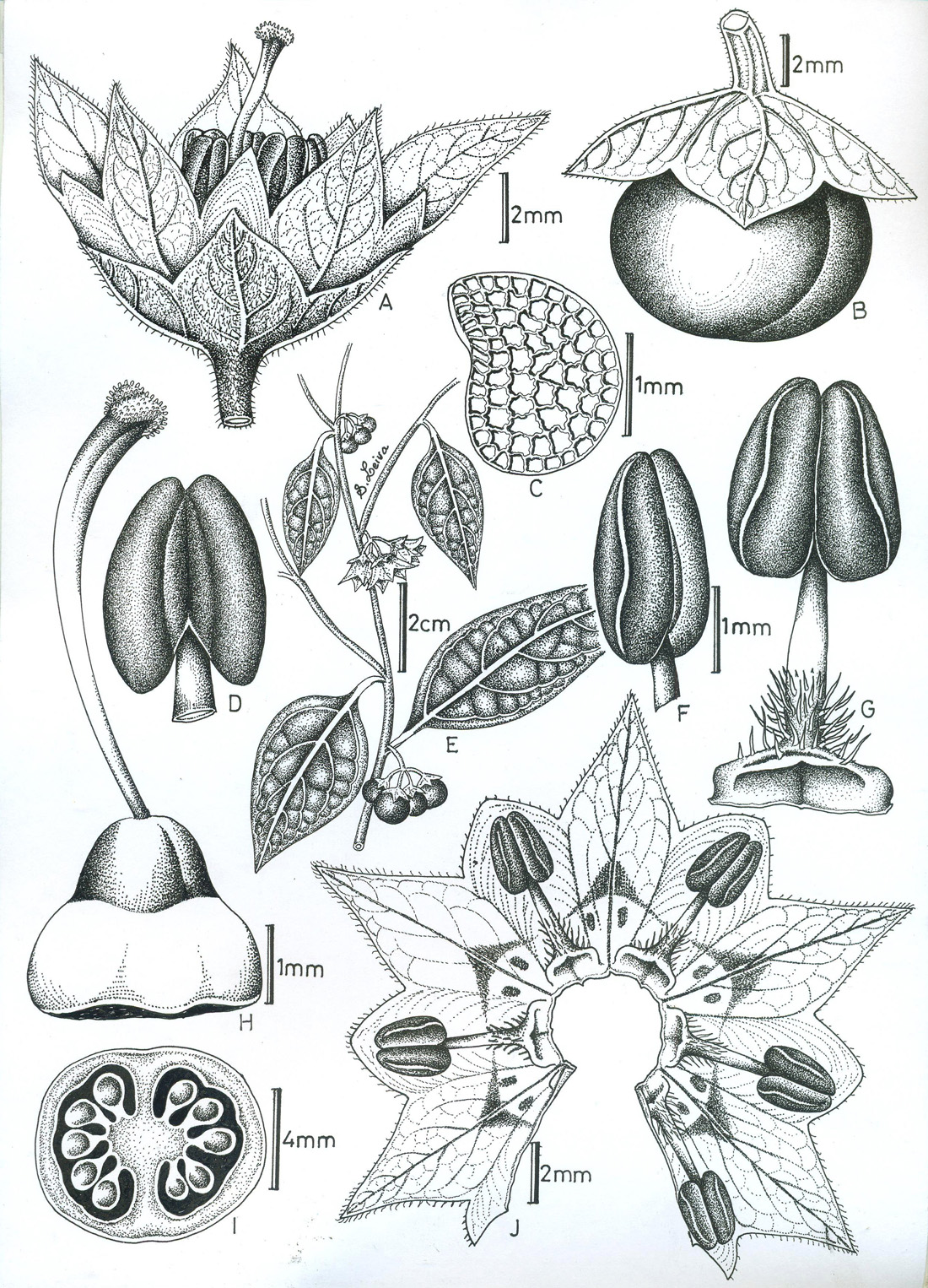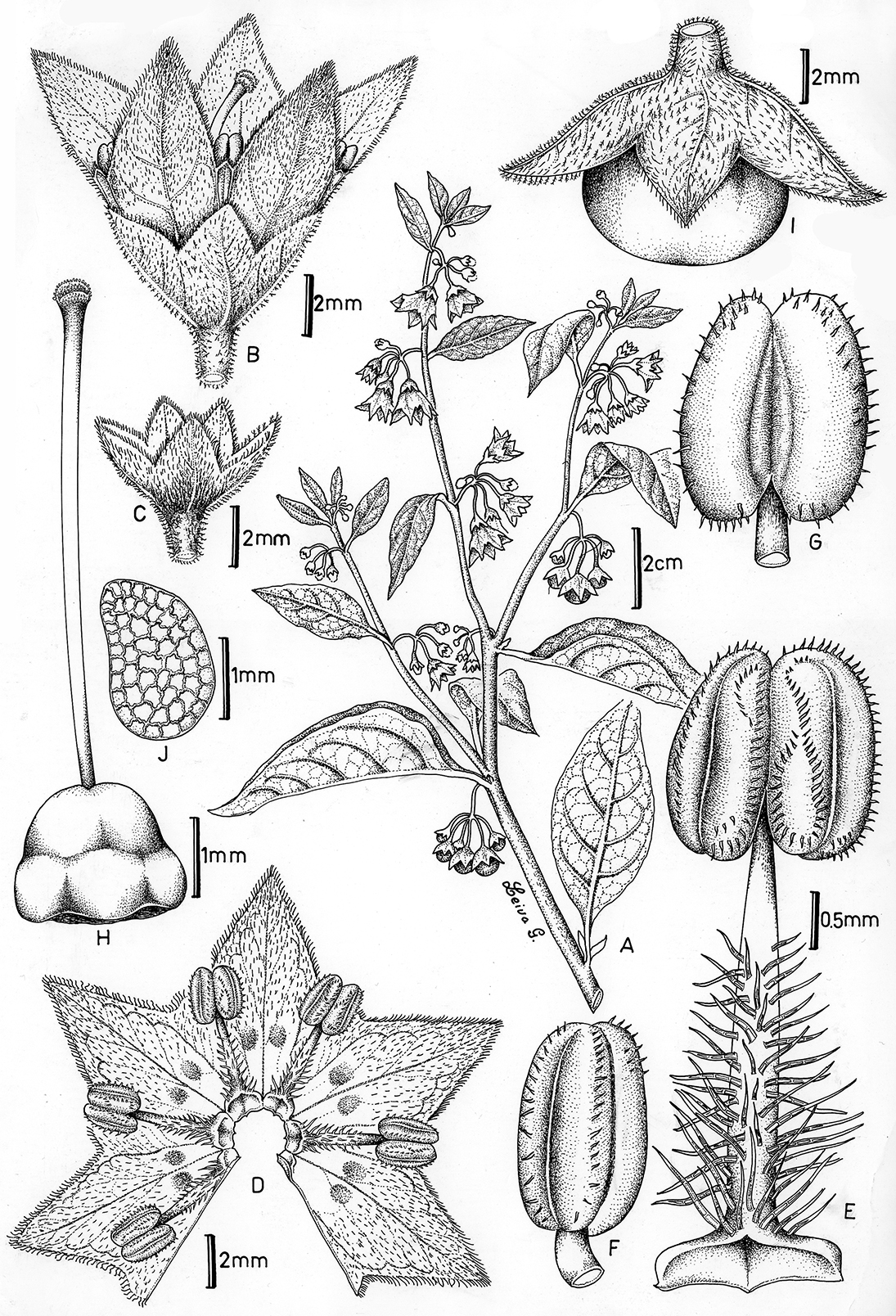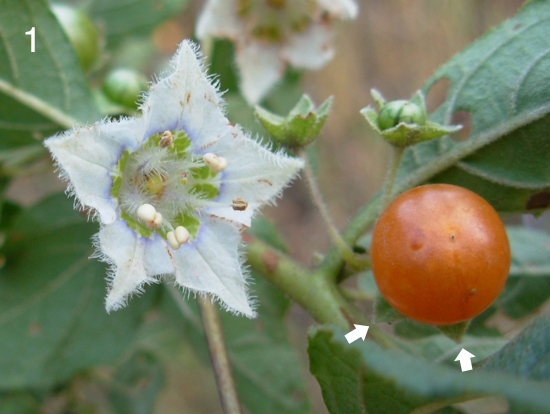 |
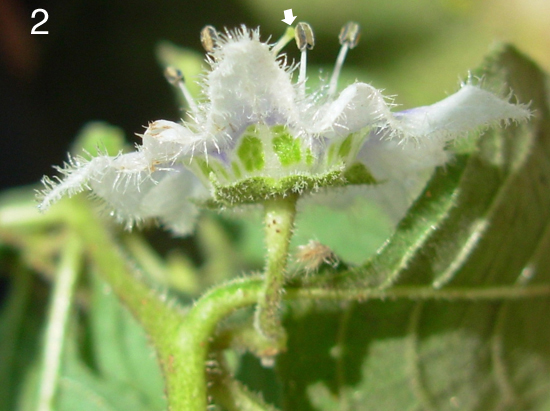 |
| Figure 1. In this flower of J. angasmarcae two anthers have dehisced and three are undehisced. The ripe berry is orange; arrows point to calyx lobes. Photo by T. Mione in Department Ancash, Mione et al. 781. |
Figure 2. Side view of flower of J. angasmarcae. Note that the tubular part of the flower increases in diameter from proximal to distal; arrow points to stigma. Photo by T. Mione in Department Ancash, Mione et al. 780. |
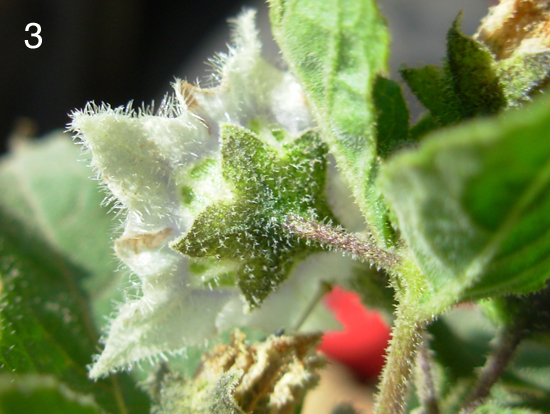 |
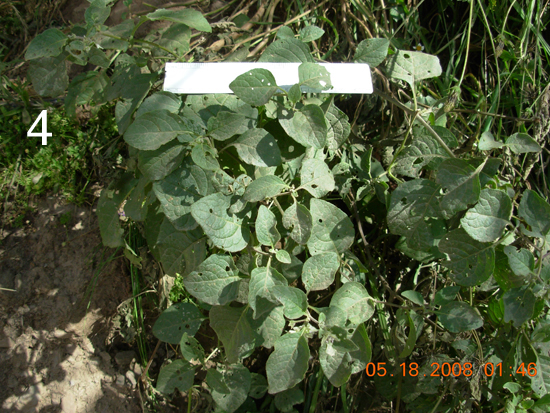 |
Figure 3. Back of flower of J. angasmarcae.
Photo by T. Mione in Department Ancash, Mione et al. 780 |
Figure 4. White bar across top of photo is a 15 cm-long ruler resting on the plant
Photo by T. Mione in Department Ancash, Mione et al. 780 |
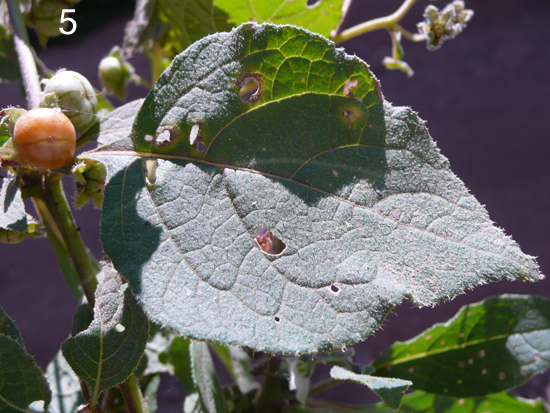 |
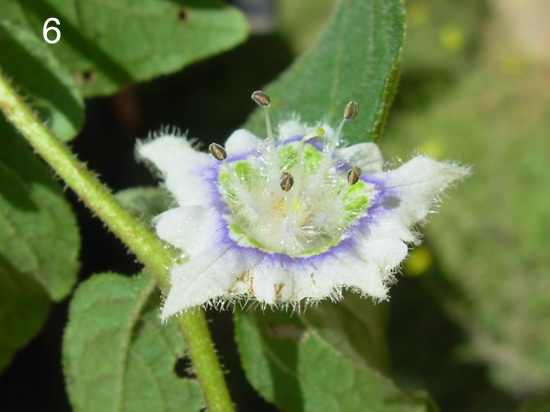 |
Fiugre 5. Ripe fruit on left, and leaf of J. angasmarcae.
Photo by Segundo Leiva G. in Department Ancash, Mione et al. 780 |
Figure 6. Flower of J. angasmarcae having dehisced anthers. Filaments angle away from style from proximial to distal, creating a spatial separation of the anthers and stigma. Photo by T. Mione in Ancash, Mione et al. 780. |
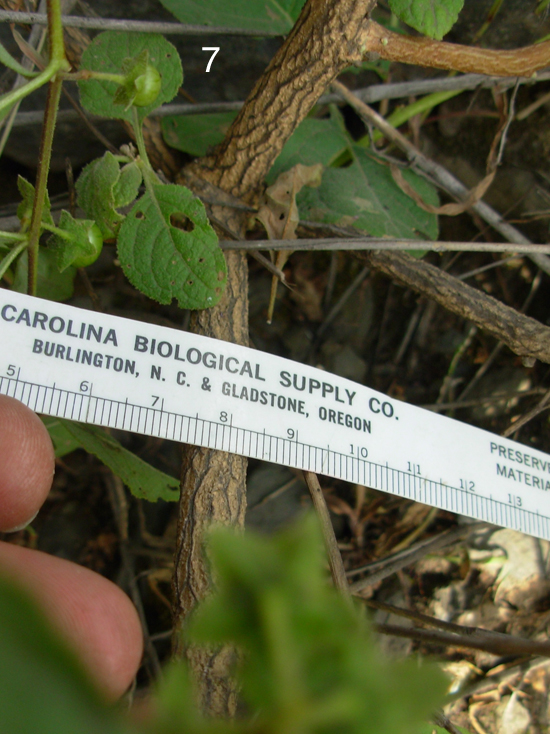 |
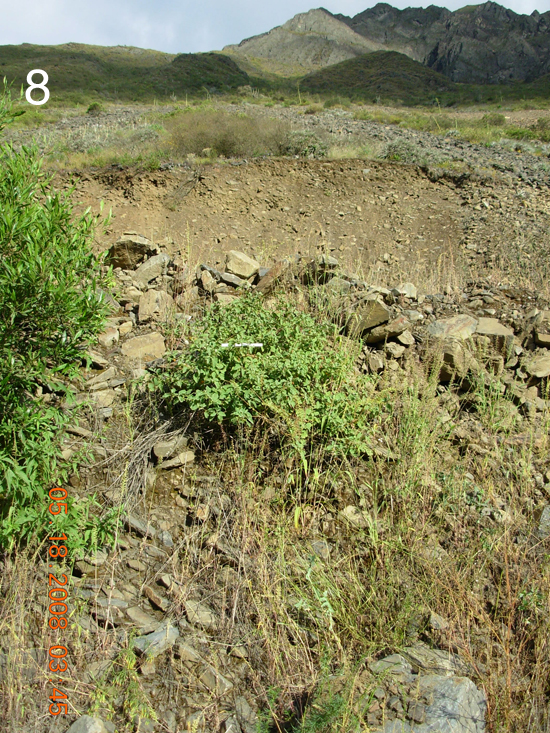 |
Figure 7. Older stem of J. angasmarcae. Unripe (green) fruit with calyx in upper left
Photo by T. Mione in Department Ancash, Mione et al. 781 |
Figure 8. Habitat of J. angasmarcae is full sun, roadside. A white ruler (15 cm long) was placed horizontally in plant and can be seen in this photo. Many orange fruits had fallen on the ground below this plant. Photo by T. Mione in Department Ancash, Mione et al. 781 |
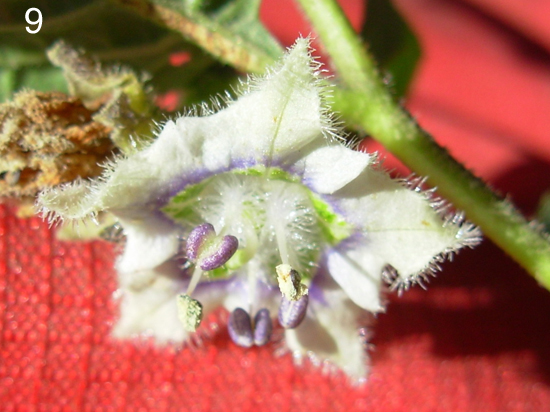 |
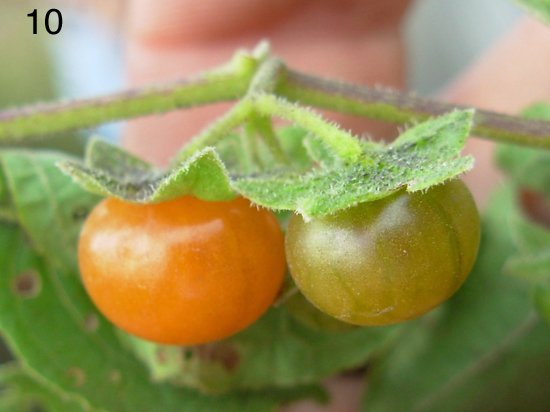 |
| Figure 9. In this flower of J. angasmarcae two anthers have dehisced, and three remain undehisced. Note that filaments are villous along lower half, the hairs unpigmented. Photo by T. Mione in Department Ancash, Mione et al. 780 |
Figure 10. Fruits of J. angasmarcae are orange when ripe
photo by T Mione in Department Ancash, Mione et al. 781. |
Table 1. Descriptions of Jaltomata angasmarcae and J. anteropilosa, considered conspecific by T. Mione. The color red is used to highlight differences between the populations.
| Character |
Description of J. angasmarcae
narrow sense, as circumscribed by Segundo Leiva G. |
Figures on this page that show J. angasmarcae |
|
Description of J. anteropilosa
considered a distinct species by Segundo Leiva G. |
Figures on this page that show J. anteropilosa |
Habit & Height |
Woody shrub to about 80 cm high, growing in full sun or very little shade |
Figs. 1 - 14,
26 - 31, 36 |
|
Woody shrub to about 80 cm high, growing in full sun or very little shade |
Figs. 15 - 25, 32 - 35 |
Branches, young |
somewhat angular (4-5 sided) when you roll young branch between fingers
pubescent, the hairs non-gland-tipped, mostly finger hairs but a few have multiple termini |
|
|
angular (4-5 sided), mostly green but purple where exposed to sun, the hairs non-gland-tipped, finger hairs |
|
older |
Terete in cross section, to about 1 cm in diameter |
|
|
Terete in cross section, surrounded by a dense
coverage of lenticels,
glabrous, with
longitudinal cracks, to 7 mm in diameter at the base |
|
Leaves, size |
The blade to 5.9 cm long X 3.5 cm at widest |
|
|
The basal leaves alternate, the distal leaves at times geminate. The blade to 4.8 cm long X 3.5 cm at widest |
|
| blade shape including margin |
ovate, asymmetrical at base |
|
|
ovate, the apex acute |
|
| blade texture |
membranous |
|
|
membranous to somewhat coriaceous |
|
| hairs |
pubescent, the hairs non-gland-tipped mostly finger hairs but a few have multiple termini |
|
|
younger leaves pubescent with short, erect finger hairs (not gland-tipped) |
|
| petiole |
to 18 mm long, pubescent |
|
|
to 15 mm long, usually shorter, pubescent like the leaves |
|
Inflorescence, flowers per inflorescence |
4 - 8 (Mione et al. 827),
3 - 5 in protologue |
|
|
8 - 13 flowers per inflorescence |
|
peduncle |
pubescent, the hairs non-gland-tipped, mostly of the finger type but a few have multiple termini (Mione et al. 781) |
|
|
4 - 8 mm |
|
pedicel |
pubescent, the hairs non-gland-tipped, mostly of the finger type but a few have multiple termini (Mione et al. 781) |
|
|
|
|
Calyx when flowering, color & size |
|
|
|
|
|
| shape / position during anthesis |
|
|
|
|
|
| hairs |
pubescent, the hairs non-gland-tipped, mostly of the finger type but a few have multiple termini (Mione et al. 781); externally densely pubescent with dendritic hairs (Mione et al. 827) |
|
|
|
|
| at fruit maturity |
green, hiding about 1/3 of fruit |
|
|
hiding about 1/4 of the berry in side-view, and shaped like a shallow bowl after fruit separates from calyx; sepal length 7 mm measured on back of calyx, the calyx 15 to 16.5 mm diameter. |
|
Corolla color |
white |
Fig 1, 2, 6, 9 |
|
white |
Fig 16 |
| green petal spots |
yes, 10, making throat green |
|
|
yes |
Fig 17 |
| purple ring |
yes, at the base of the limb where the limb meets the tube / throat |
Fig 6 |
|
yes, at the base of the limb where the limb meets the tube / throat;, presence absence variation in one population |
Fig 16 |
shape and size |
short-tubular with a rotate limb, the tube increasing in diameter from proximal to distal |
Fig 2 |
|
short-tubular with a rotate limb, the tube increasing in diameter from proximal to distal |
Fig 16 |
lobes / lobules |
5 lobes and 5 lobules alternating (Mione et al. 780, 781)
Mione's photos of the type collection (Fig. 11, 12, 27, 28, 30) show 5 lobes, not 10, but S. Leiva G.'s illustration of the type collection clearly shows 5 lobes and 5 lobules alternating |
Fig 2, 3, 9 and cultivated plants of 649 not shown, but not always evident in any one view as one can see in Fig 1 |
|
5 lobes and 5 lobules alternating |
Fig 16 |
|
the margin ciliate |
Fig 1, 3, 11 |
|
the margin ciliate |
Fig 16 |
|
no |
|
|
no |
|
|
no |
|
|
no |
|
Stamen length including anther |
stamens angle away from style |
Fig 9 |
|
7 mm |
Fig. 17 |
| length stamens exserted beyond distal end of corolla (applicable if corolla is tubular or campanulate) |
|
|
|
4 mm
estimated from Fig. 18 |
Fig. 18 |
| position of stamens: a) before anthers dehisce, b) after anthers dehisce |
|
|
|
|
Fig. 19 |
| base expanded laterally? |
yes |
|
|
|
|
| filaments |
Villous along about 50 % of the length; purple proximally but the filament hairs unpigmented (Mione et al. 781) |
|
|
Villous along about 60% of the length; purple proximally on some plants and purple from base nearly to the top on other plants in same population. |
Fig. 17 |
| anther hairs |
glabrous (Mione et al. 827) |
|
|
pubescent on inner face, the hairs whitish |
|
| anther color |
Purple (Mione et al. 780);
pale-yellow (Mione et al. 781) |
Fig. 9, 1 |
|
Purple |
Figs. 19, 20, 23, 33, 34 |
| anther size |
|
|
|
|
|
| anther mucronate/mucronulate |
no |
|
|
no |
23 |
| insertion of filament into anther |
|
|
|
base of ventral face |
|
| anthers of a flower open simultaneously? |
|
|
|
no |
16, 17, 19, 23 |
| pollen quantity per flower |
|
|
|
no data |
|
| pollen grain size |
|
|
|
no data |
|
Gynoecium, stigma |
glabrous except for microscopistigma papillae.
0.57 mm perpendicular to length*, figures 2 & 6; at height of dehisced anthers on field-studied flowers (780, 781) and exserted 4 mm beyond anthers on cultivated plants of 649. |
|
|
|
|
Style |
5.2 to 6.5 mm* long.
11.7 mm (on cultivated plants of 649) |
|
|
|
|
| Ovary & Ovarian Disk |
disk is about 50% of the total ovary height |
|
|
|
|
Nectar |
transparent |
|
|
|
|
| Herkogamy |
yes |
Fig. 6 |
|
yes |
Fig. 20 center flower |
| Protogyny |
yes |
Fig. 27 |
|
yes |
Fig. 20 upper right flower |
Fruit color (at maturity) and size |
orange,
7 X 9 mm (fresh not pressed, 781)
8 X 10 mm (fresh not pressed, 649)
9 X 10 mm (fresh not pressed, Mione et al. 827) |
1, 10, 26 |
|
orange, 7 X 10 mm, 9 X 12.5 mm both fresh not pressed, the first measure being from pedicel attachment to opposite pole |
16, 20, 33, 34 |
Seeds per fruit |
91 per fruit from a fruit 8 X 10 mm (781),
50 per fruit from one fruit of size 7 X 9 mm (781); 54 and 71 seeds per fruit (649) |
|
|
76 - 153
93, 113, 153 counts by T. M. and a count of 76 by S. L. G. |
|
Seed Size |
|
|
|
|
|
Peru, Department
Province |
Locality |
elevation |
habitat |
date |
collector |
regarded by Segundo Leiva G. as |
La Libertad
Santiago de Chuco |
Angasmarca
S 08 08.044
W 78 03.012 |
about 2,880 |
roadside |
25 Mar 2013 |
TYPE COLLECTION of J. angasmarcae
S. Leiva G., T. Mione & L. Yacher 5420
Holotype: HAO
|
J. angasmarcae |
La Libertad
Santiago de Chuco |
Angasmarca
S 08 08.044
W 78 03.012 |
about 2,880 |
roadside |
25 Mar 2013 |
collected at same place and at same time as type collection:
T. Mione, S. Leiva G. & L. Yacher 827
|
J. angasmarcae |
La Libertad
Santiago de Chuco |
Angasmarca |
2,900 m |
in loose thicket mixed with grasses |
March 1916 |
Weberbauer 7197, type specimen of Hebecladus weberbaueri Bitter (US). |
J. angasmarcae |
| |
|
|
|
|
|
|
Ancash
Pallasca
|
Rio Tablachaca
08 16' 44.1, 78 02' 08.7 |
2,667 m |
roadside |
18 May 2008 |
Mione, Leiva & Yacher 780
Leiva, Mione & Yacher 4425 (HAO) |
J. angasmarcae |
Ancash
Pallasca |
Rio Tablachaca
08 12' 35.3, 77 56' 50.4 |
2,453 m |
roadside, full sun |
18 May 2008 |
Mione, Leiva & Yacher 781
Leiva, Mione & Yacher 4427 (HAO) |
J. angasmarcae |
Ancash
Corongo |
town of Corongo, 8 34' 24.3" S, 77 53' 38.2" W |
3,173 m |
tall rock wall in town |
18 May 2015 |
Mione, Leiva & Yacher 859
|
J. anteropilosa |
Ancash
Corongo |
town of Corongo, 8 34' 24.3" S, 77 53' 38.2" W |
3,173 m |
graveyard, open sun |
18 May 2015 |
TYPE COLLECTION of J. anteropilosa
Mione, Leiva & Yacher 860
Leiva, Mione & Yacher 5885 (HAO) |
J. anteropilosa |
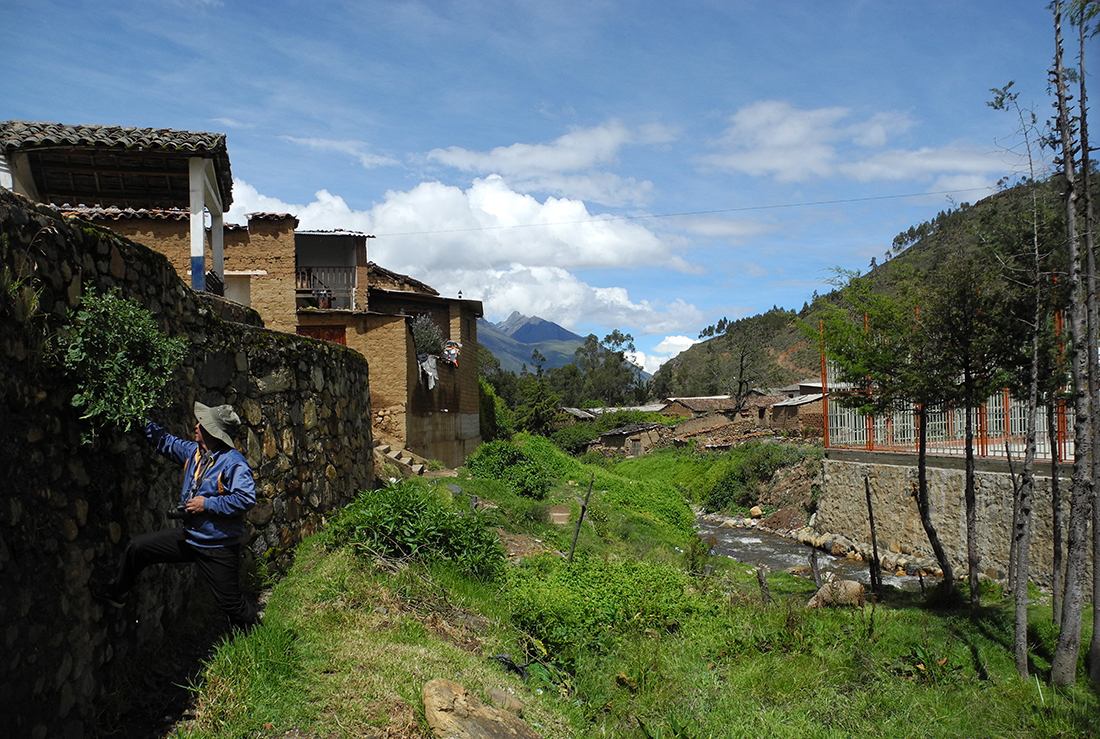 |
Figure 15, above. Segundo Leiva G. is reaching out to a Jaltomata plant Mione et al. 859. Photo by T. Mione in Department Ancash, province Corongo, Peru.
Segundo Leiva G. maintains that the Corongo population is a distinct species, J. anteropilosa but T. Mione identifies this population as J. angasmarcae. |
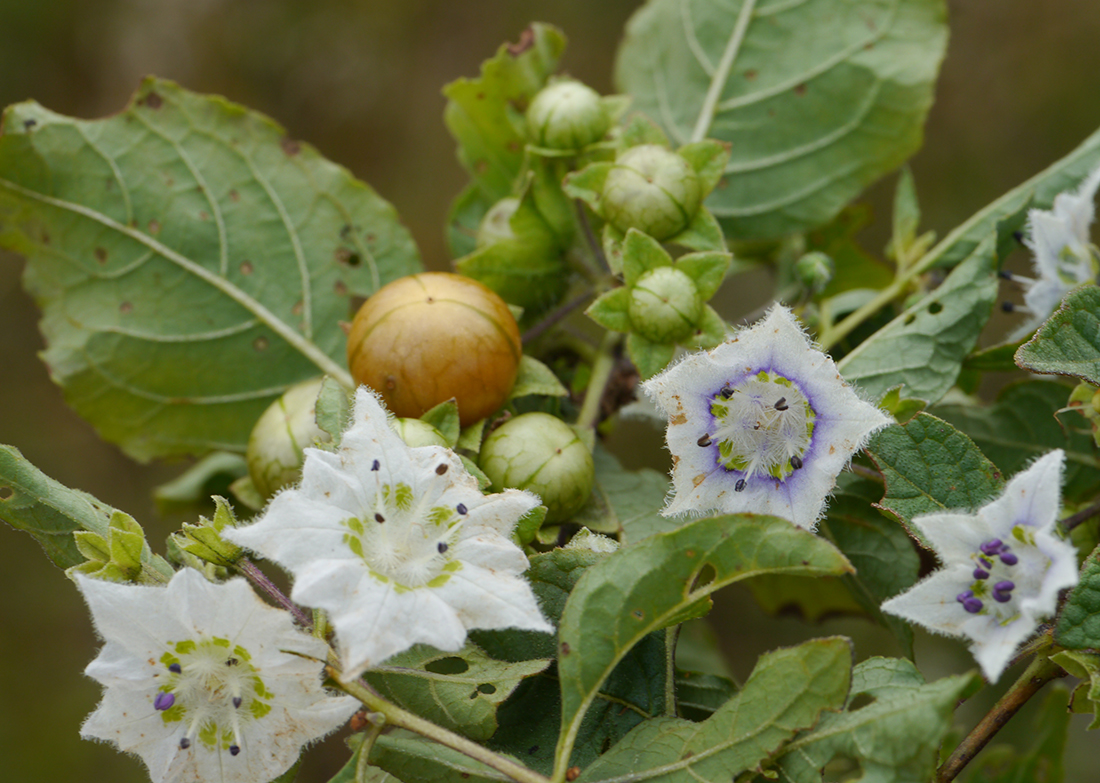 |
| Figure 16, above. Mione et al. 860. Photo by T. Mione in Department Ancash, province Corongo, Peru. Segundo Leiva G. maintains that the Corongo population is a distinct species, J. anteropilosa but T. Mione identifies this population as J. angasmarcae. |
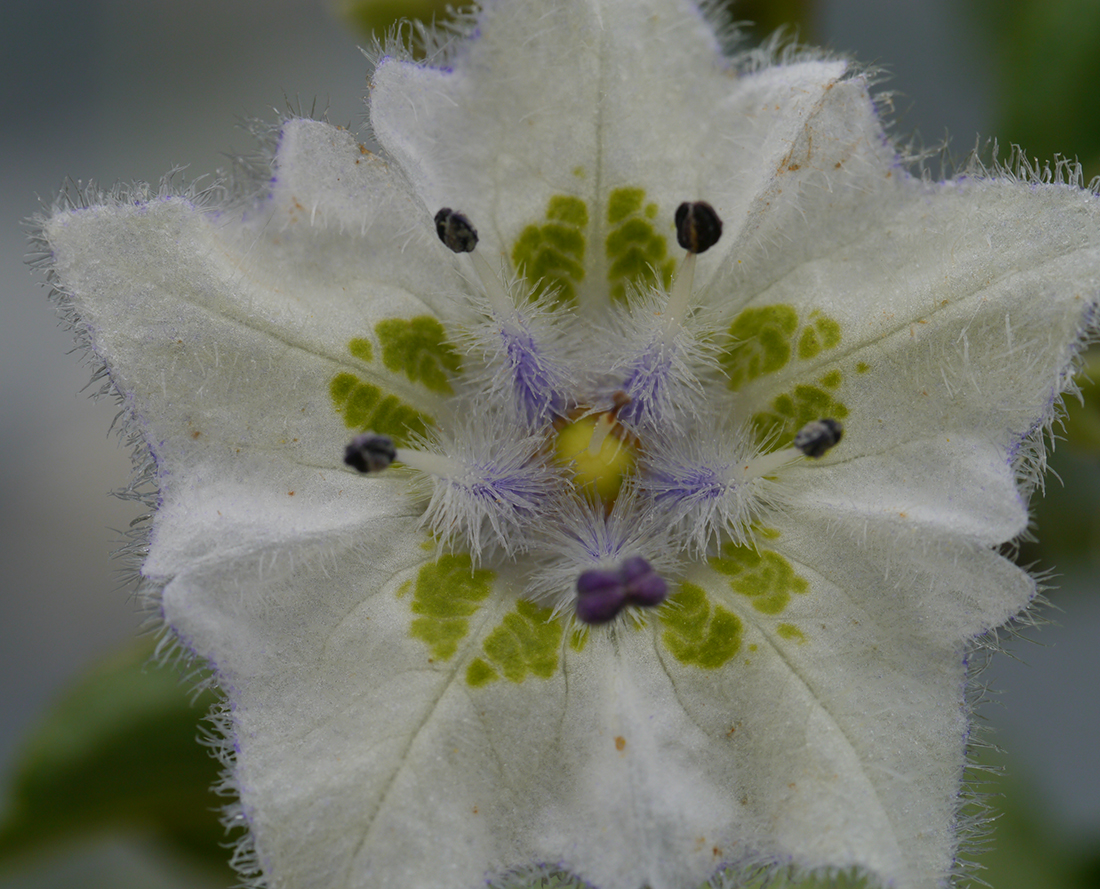 |
Figure 17, above. Flower. Mione et al. 860. Photo by T. Mione in Department Ancash, province Corongo, Peru.
Segundo Leiva G. maintains that the Corongo population is a distinct species, J. anteropilosa but T. Mione identifies this population as J. angasmarcae. |
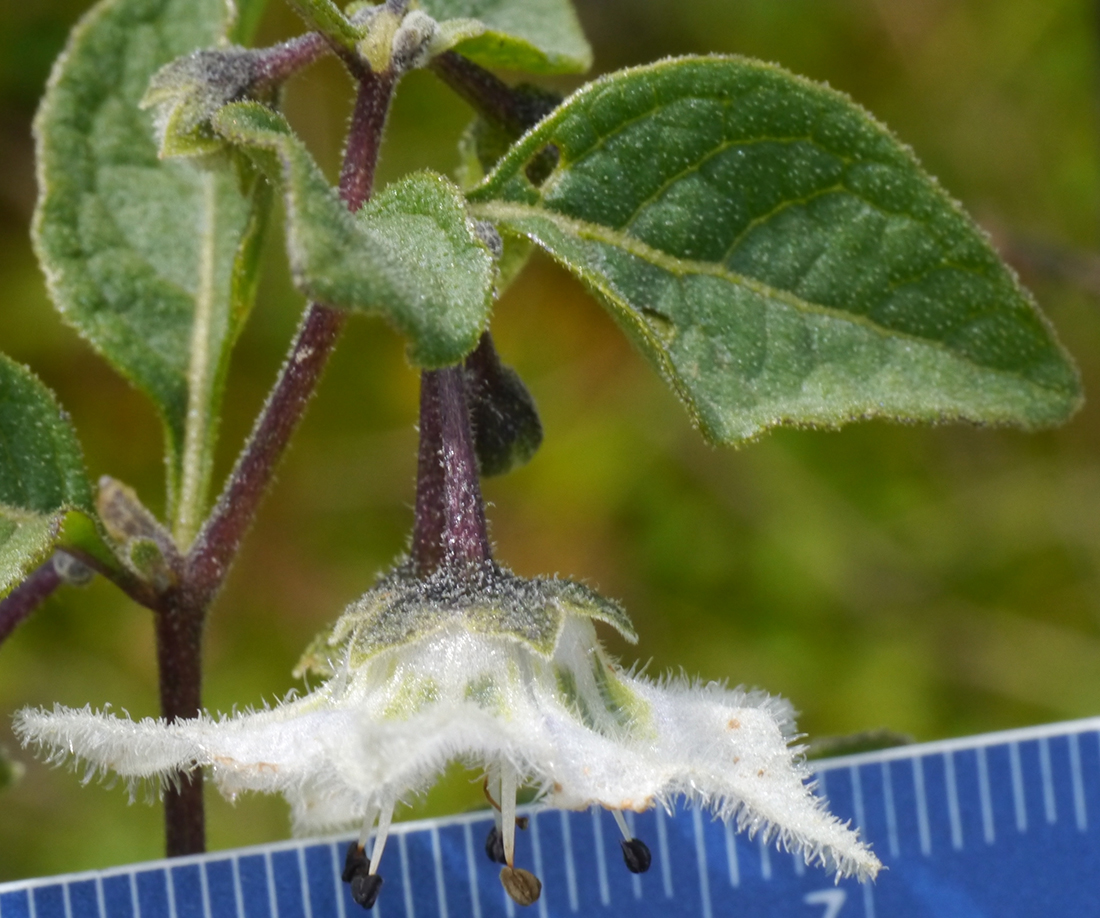 |
Figure 18, above. Mione et al. 860. Smallest units are mm. Photo by T. Mione in Department Ancash, province Corongo, Peru.
Segundo Leiva G. maintains that the Corongo population is a distinct species, J. anteropilosa but T. Mione identifies this population as J. angasmarcae. |
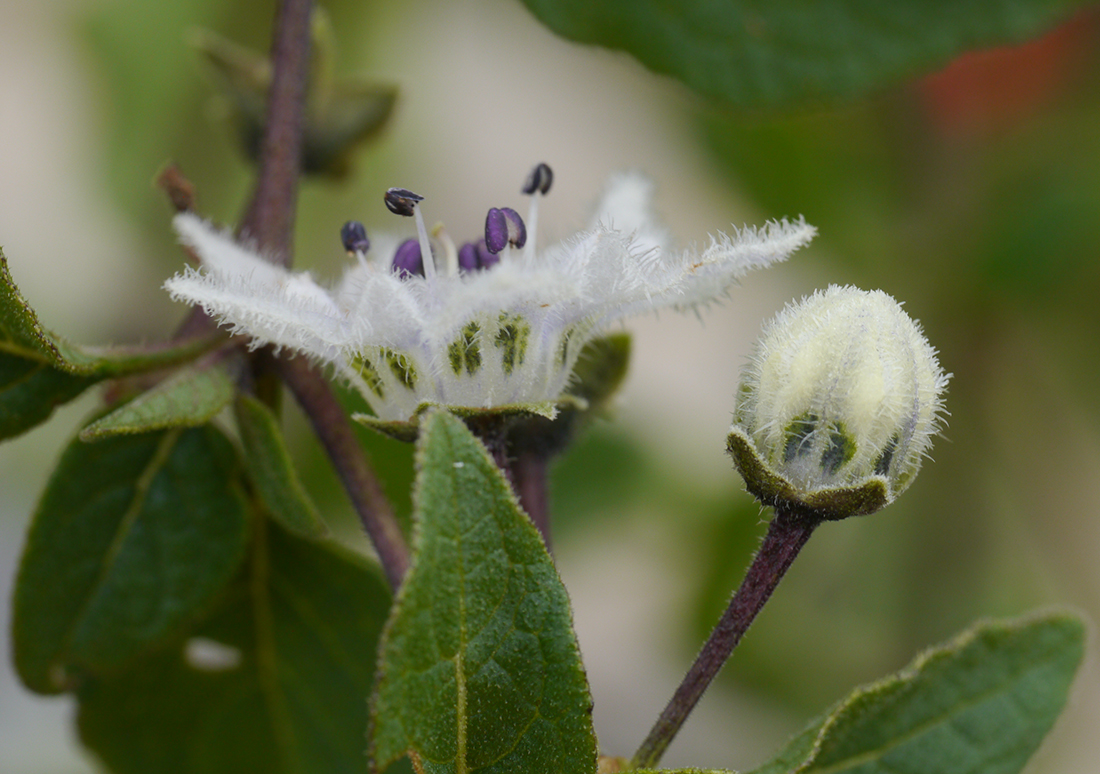 |
Figure 19, above. Note that anthers of a flower do not dehisce simultaneously. Mione et al. 860. Photo by T. Mione in Department Ancash, province Corongo, Peru.
Segundo Leiva G. maintains that the Corongo population is a distinct species, J. anteropilosa but T. Mione identifies this population as J. angasmarcae. |
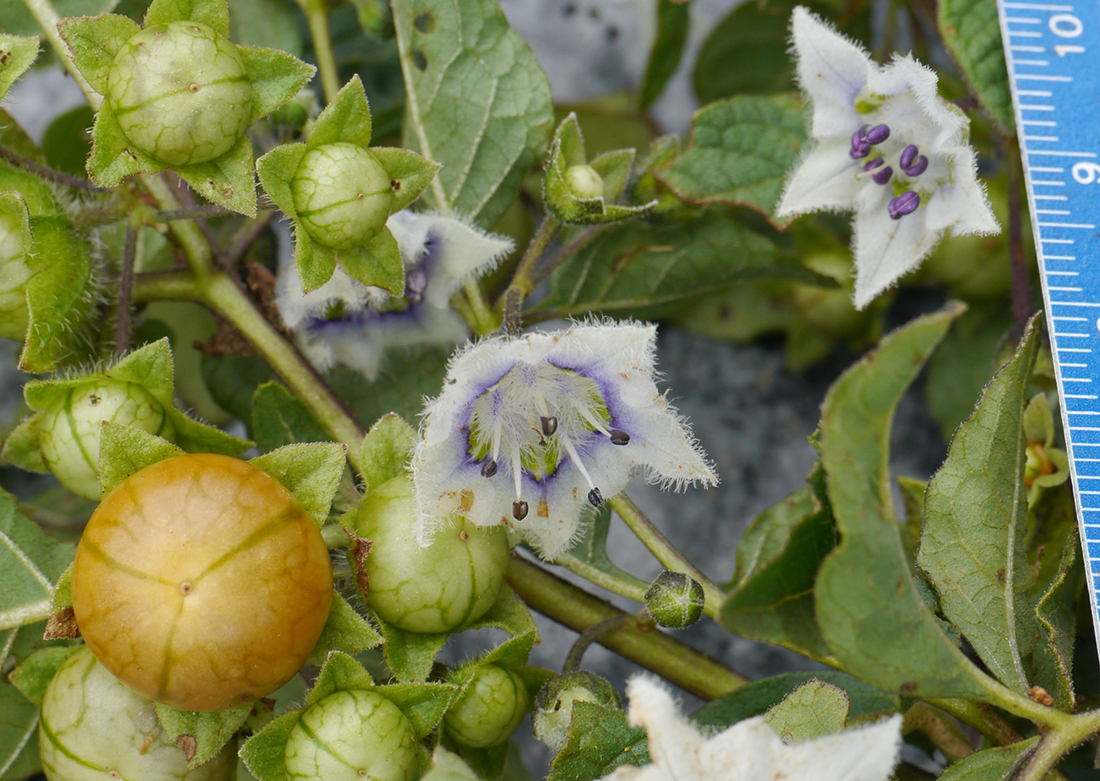 |
| Figure 20, above. Mione et al. 860. Smallest units at right are mm. Photo by T. Mione in Department Ancash, province Corongo, Peru. Segundo Leiva G. maintains that the Corongo population is a distinct species, J. anteropilosa but T. Mione identifies this population as J. angasmarcae. |
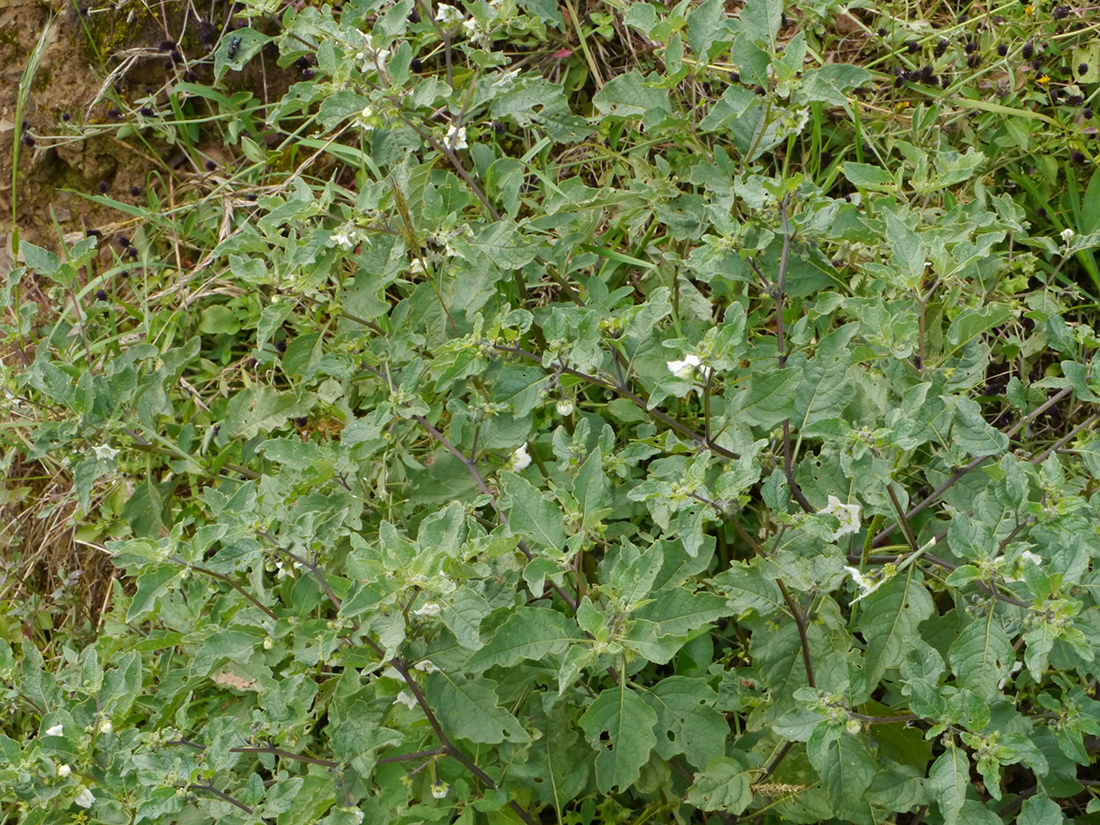 |
| Figure 21, above. Mione et al. 860. Photo by T. Mione in Department Ancash, province Corongo, Peru. Segundo Leiva G. maintains that the Corongo population is a distinct species, J. anteropilosa but T. Mione identifies this population as J. angasmarcae. |
 |
| Figure 22, above. Mione et al. 860. Units along left are mm. Photo by T. Mione in Department Ancash, province Corongo, Peru. Segundo Leiva G. maintains that the Corongo population is a distinct species, J. anteropilosa but T. Mione identifies this population as J. angasmarcae. |
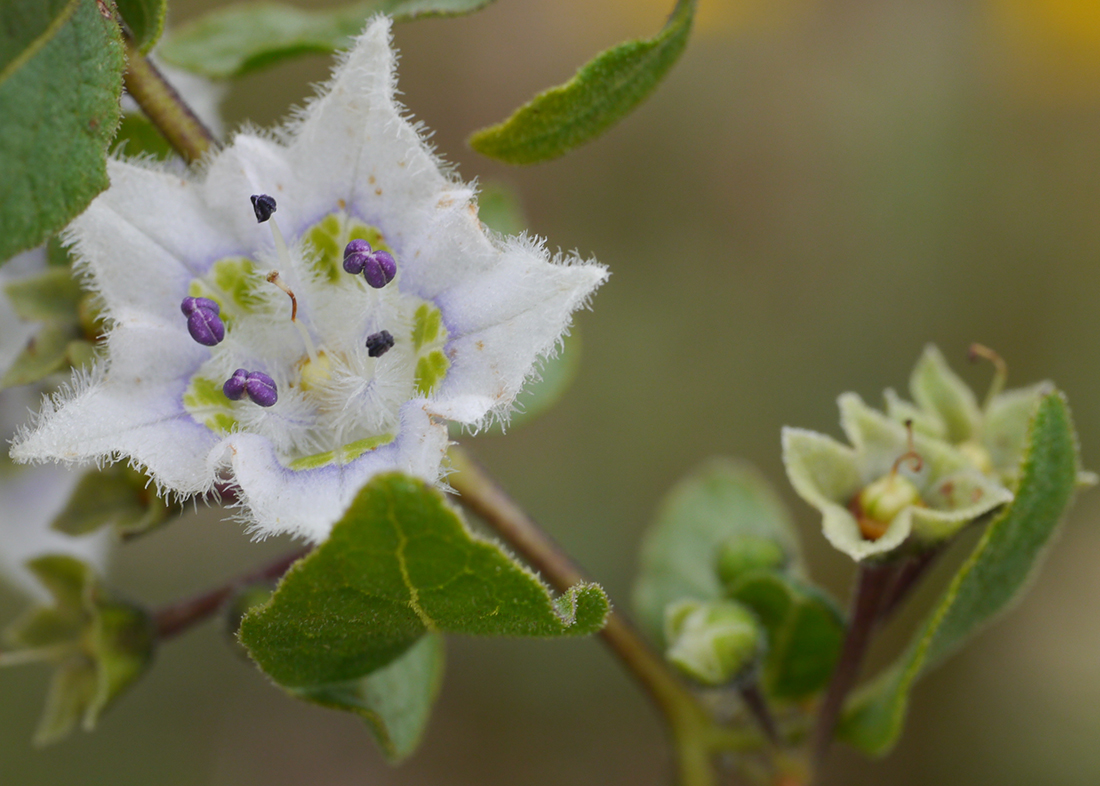 |
| Figure 23, above. Mione et al. 860. Photo by T. Mione in Department Ancash, province Corongo, Peru. Segundo Leiva G. maintains that the Corongo population is a distinct species, J. anteropilosa but T. Mione identifies this population as J. angasmarcae. |
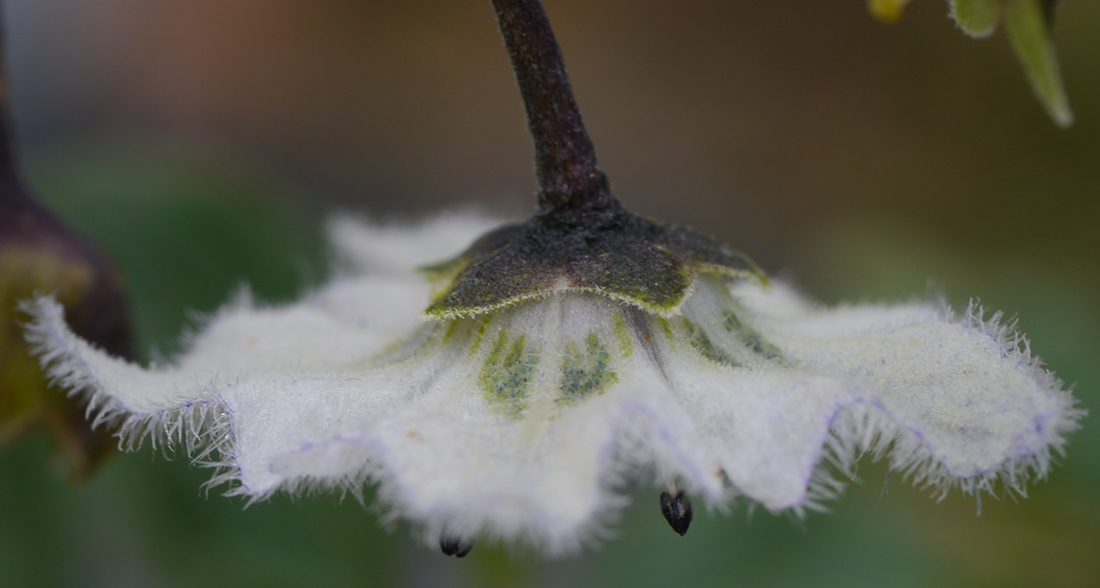 |
| Figure 24, above. Mione et al. 860. Photo by T. Mione in Department Ancash, province Corongo, Peru. Segundo Leiva G. maintains that the Corongo population is a distinct species, J. anteropilosa but T. Mione identifies this population as J. angasmarcae. |
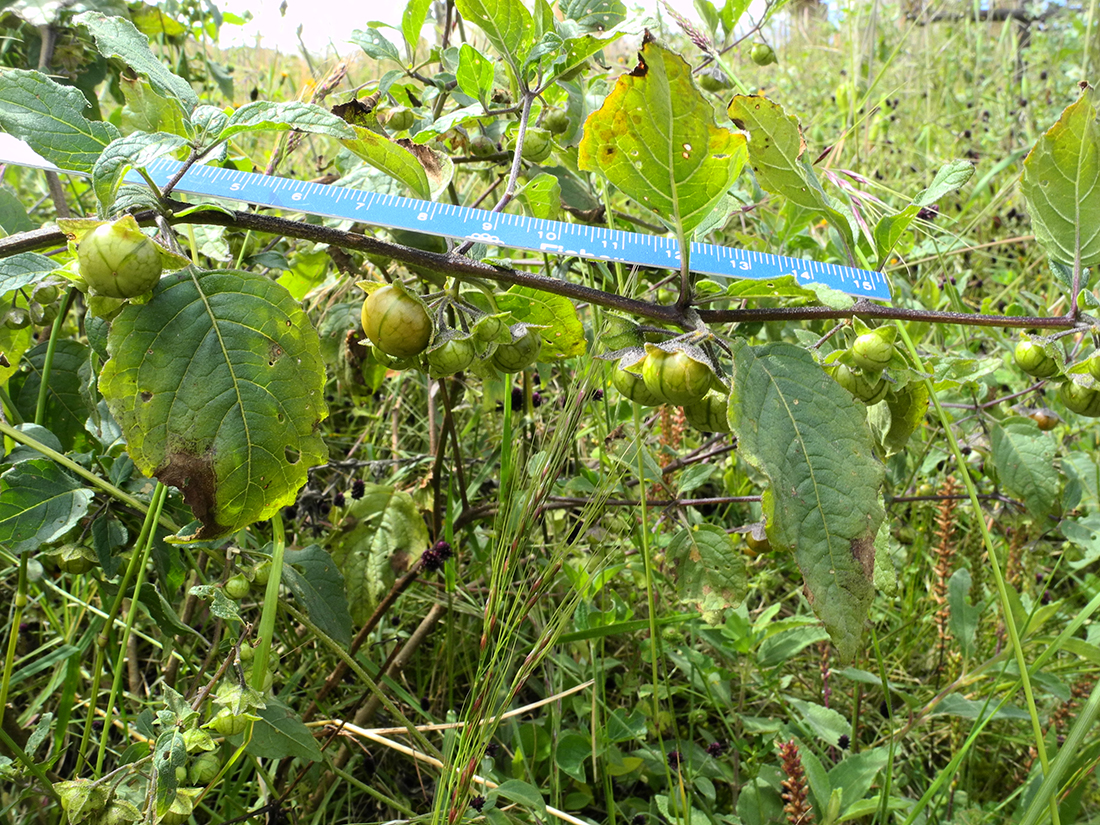 |
| Figure 25, above. Corongo, Peru. Numbered units are cm. Photo by T. Mione in Department Ancash, province Corongo, Peru. Segundo Leiva G. maintains that the Corongo population is a distinct species, J. anteropilosa but T. Mione identifies this population as J. angasmarcae. Mione et al. 860. |
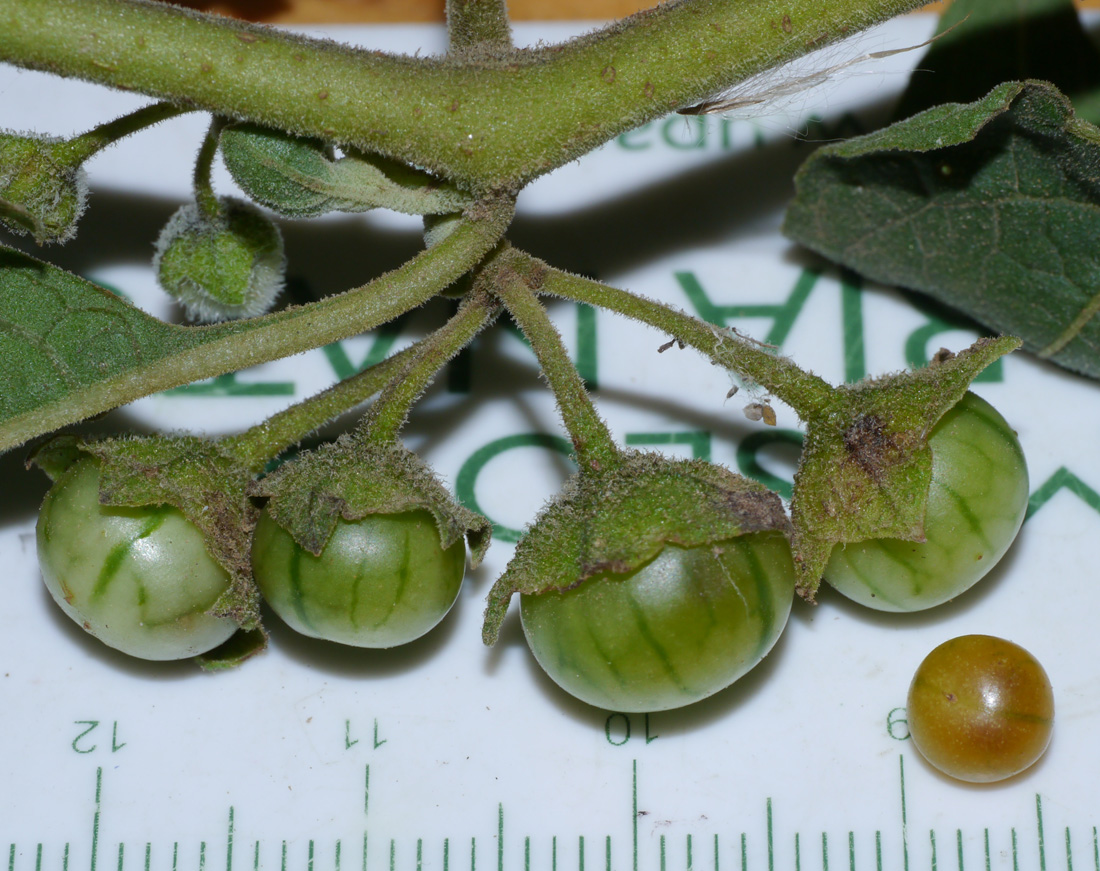 |
| Figure 26, above. Fruits, mostly unripe, of Jaltomata angasmarcae. Smallest units along bottom are mm, numbered units are cm. Mione et al. 827, photo by Thomas Mione in Department La Libertad. |
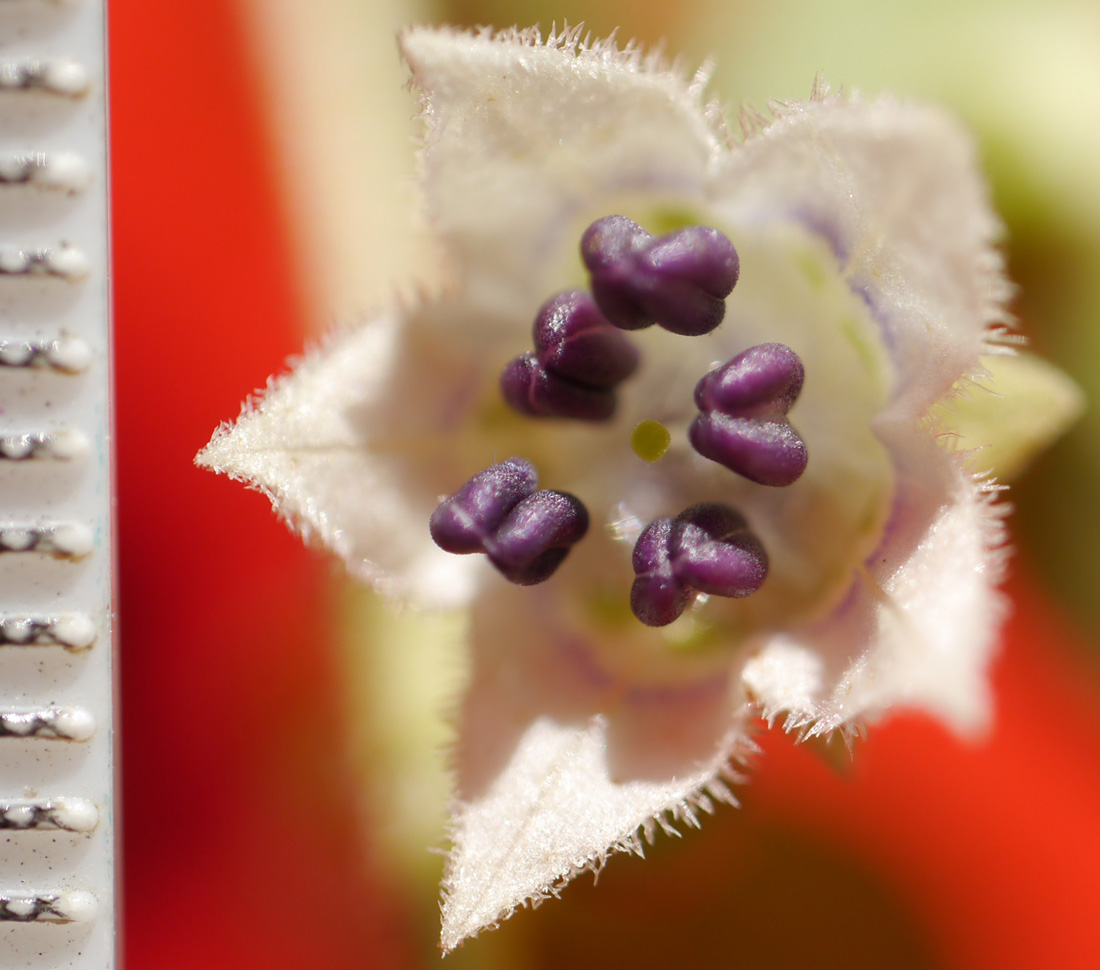 |
| Figure 27, above. Flower in pistillate phase (all anthers undehisced), Jaltomata angasmarcae. Units vertically on left are mm, Mione et al. 827, photo by Thomas Mione in Department La Libertad. |
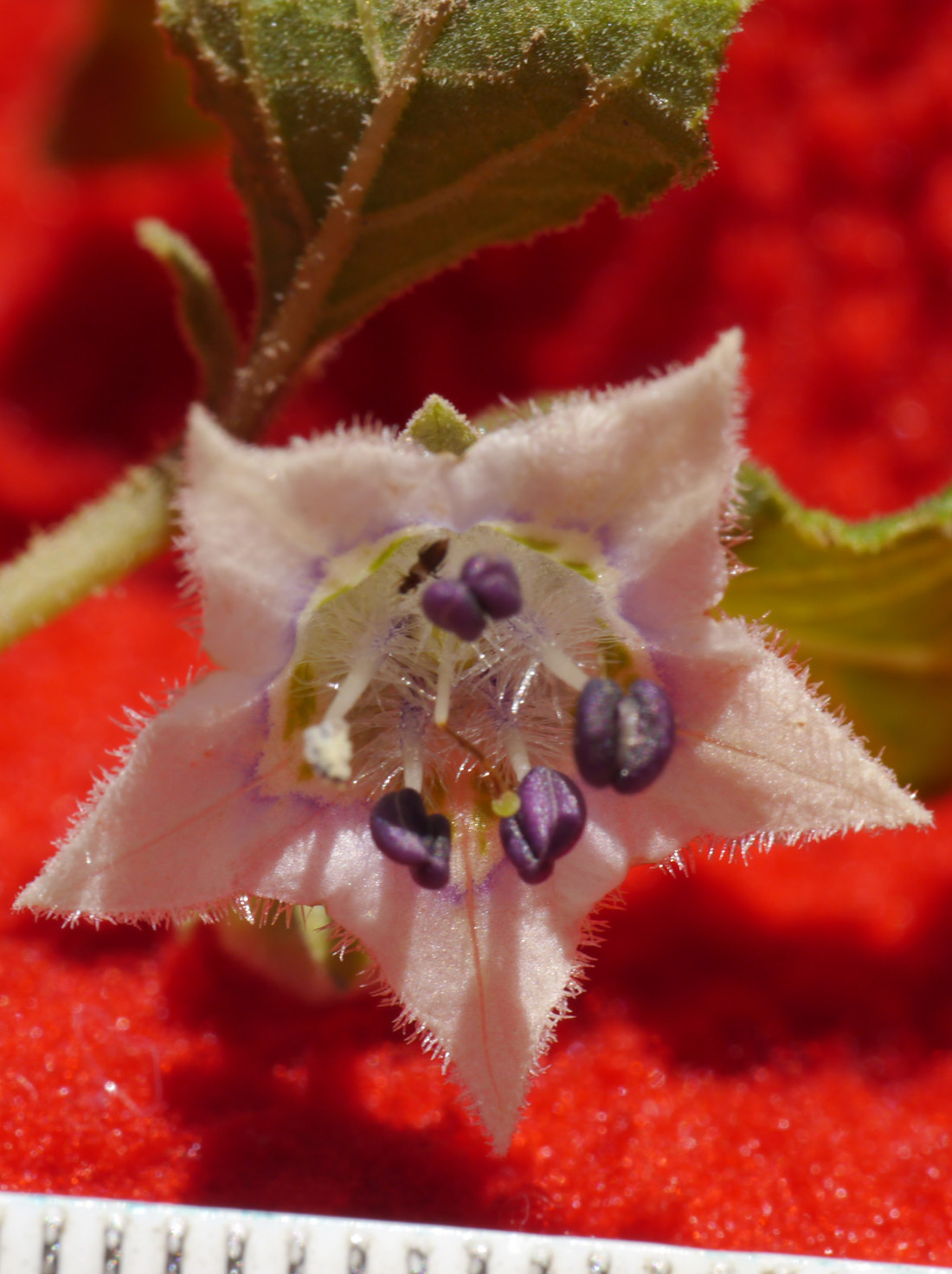 |
| Figure 28, above. Flower of Jaltomata angasmarcae transitioning from pistillate phase to hermaphroditic phase. Note four anthers undehisced, one anther dehisced, units along bottom are mm, Mione et al. 827, photo by Thomas Mione in Department La Libertad. |
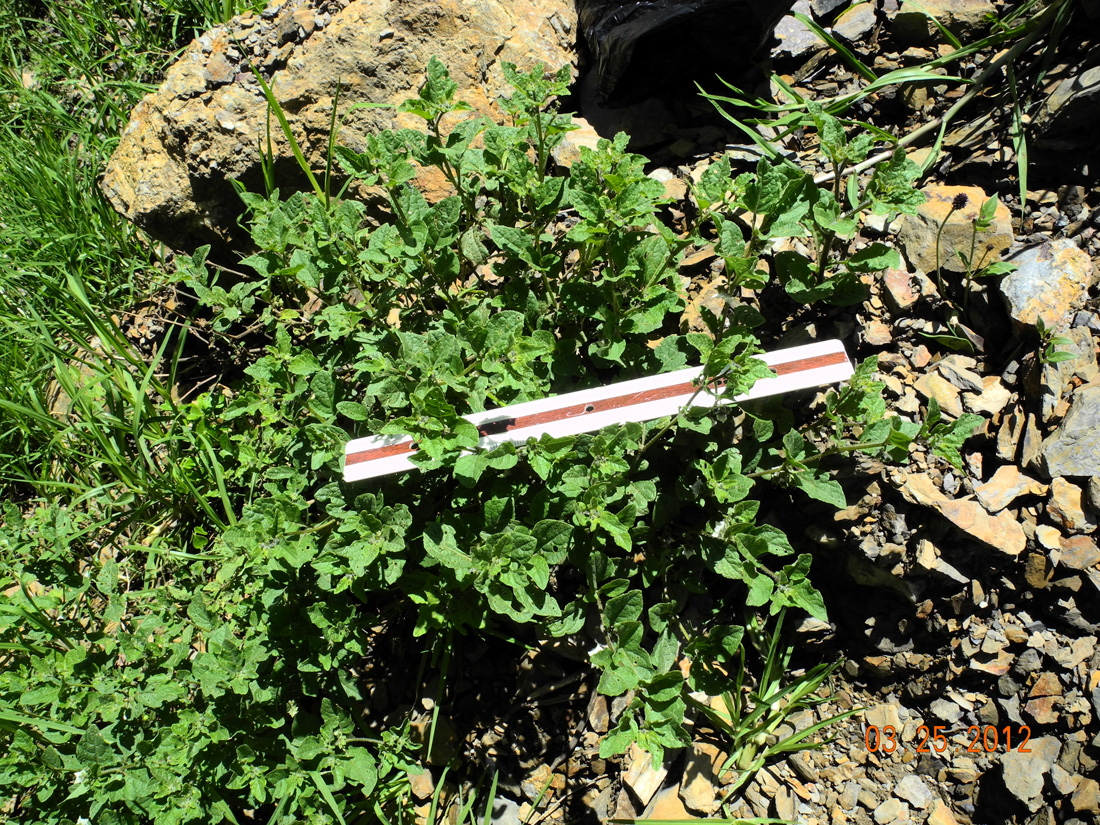 |
| Figure 29, above. Jaltomata angasmarcae (the ruler is 30.5 cm long, Mione et al. 827, photo by Thomas Mione in Department La Libertad; the date printed on this photo is off by one year... the collection was made on 25 Mar 2013) |
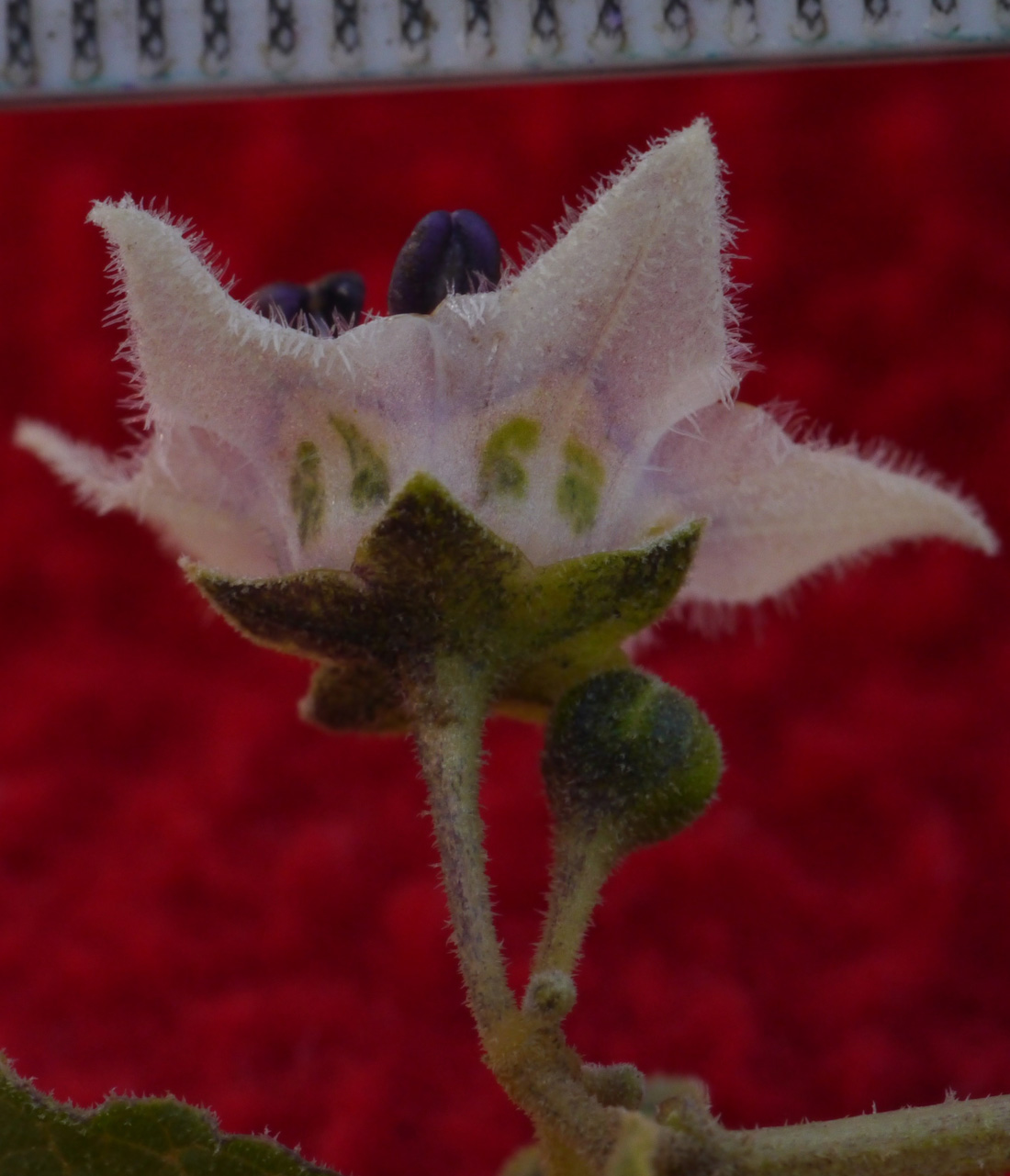 |
| Figure 30, above. Flower of Jaltomata angasmarcae (units horizontally along top are mm, Mione et al. 827, photo by Thomas Mione in Department La Libertad). |
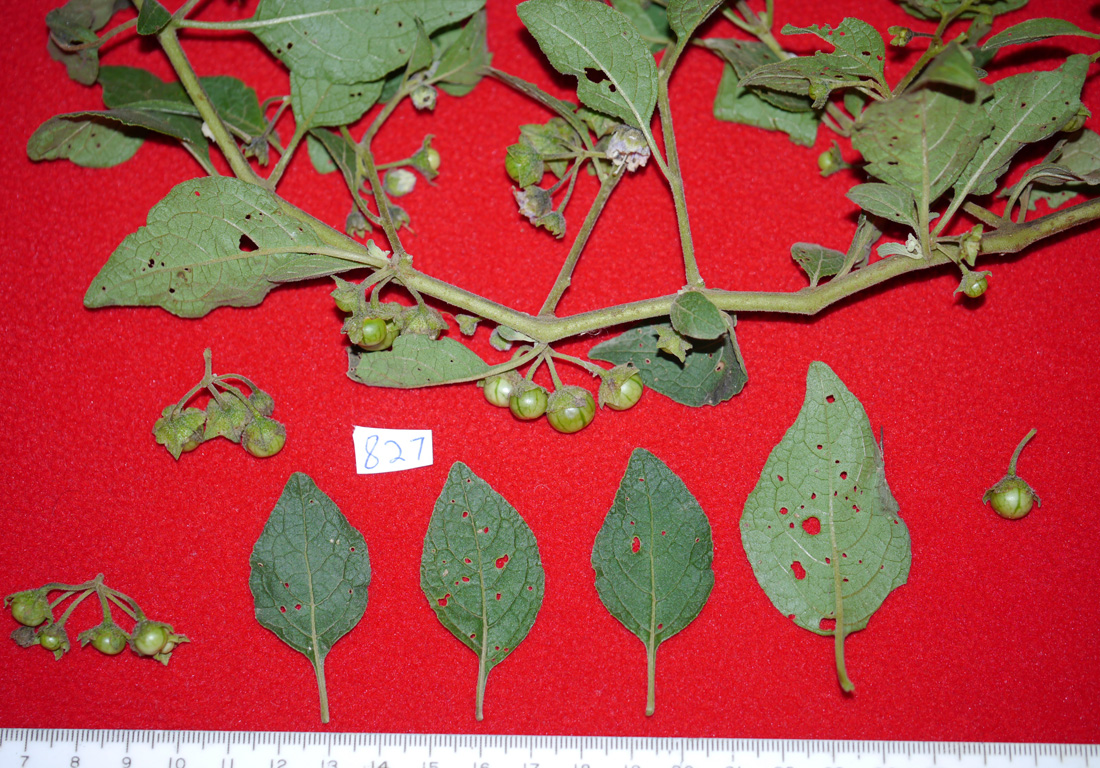 |
| Figure 31, above. Jaltomata angasmarcae (along the bottom the three leaves on the left show their upper / adaxial face while the leaf on the right is showing its lower / abaxial face; smallest units along bottom are mm, numbered units are cm, Mione et al. 827, photo by Thomas Mione in Department La Libertad). |
The following four photos are from Corongo, Department Ancash, northern Peru.










